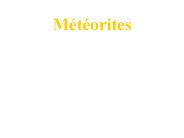Chondrule PowerPoint PPT Presentations
All Time
Recommended
The line labeled CCAM is the carbonaceous chondrite anhydrous mineral line, designating where chondrules and other materials in carbonaceous chondrites plot.
| PowerPoint PPT presentation | free to download
Chondrules are mysterious millimeter-sized rocky droplets in chondritic meteorites. They formed during the first 5 million years of the Solar System, have diverse
| PowerPoint PPT presentation | free to download
SIMS (high spatial resolution) Internal isochron for chondrules ... e.g.dating of chondrules. Mn-Cr cannot be used because the initial in CAIs are strange. ...
| PowerPoint PPT presentation | free to download
Planetesimal heating. 26Al as tool for radiometric dating: ... 26Al as planetesimal heat source: ... stronger heated planetesimals have earlier formed chondrule ...
| PowerPoint PPT presentation | free to download
... Meridiani from the outset: haematite chondrules, sedimentary rocks with ... with 2-5 times high S & Cl concentrations than interior, crystalline haematite. ...
| PowerPoint PPT presentation | free to view
chondrule rims noble gas-rich: rims did form in nebula, not on ... asteroid belt arrived within 105 - 106 years. 100 m ~1 Myr. 21Ne exposure age difference ...
| PowerPoint PPT presentation | free to view
Absence of magnetic moment on 433 Eros may not be surprising and can be ... Non-magnetic nature of Eros is due to absence of significant homogeneous ...
| PowerPoint PPT presentation | free to view
BUMI DALAM TATASURYA Matahari dan planet-planetnya Anatomi bumi Dinamika bumi MODUL 2 - TATASURYA * * MODUL 2 - TATASURYA * A GALAXY IS BUILT BY MANY SOLARS SYSTEM ...
| PowerPoint PPT presentation | free to download
pluie ' m t oritique sur notre atmosphere est de 1000 10 000 tonne par jour ... La chaleur produit un m tamorphisme qui permet aux volatiles de s' chapper ...
| PowerPoint PPT presentation | free to download
... Oxygen Isotopes in Meteorites Outline Meteorite Summary Oxygen Isotopes Three-isotope correlation diagram Fractionation Terrestrial Fractionation line ...
| PowerPoint PPT presentation | free to download
An Even More Precise View of Aluminum-26 in the Solar Nebula 26Al might have come from: Active stars before the Solar System formed, or Radiation of dust near the ...
| PowerPoint PPT presentation | free to download
Most meteorites that fall on Earth are fragments of brokenup asteroids which orbit the Sun mostly be
| PowerPoint PPT presentation | free to download
Short-lived nuclides in the early solar system and their half-lives: 26Al ... nuclide chronometers relative to. U-Pb-Pb: 26Al 26Mg (0.72 Ma) 129I 129Xe (16 Ma) ...
| PowerPoint PPT presentation | free to view
Title: Supernova Confetti in Meteorites Author: gjtaylor for PSRD Keywords: chromium, Cr, isotope, anomaly, spinel, Orgueil, Murchison Last modified by
| PowerPoint PPT presentation | free to download
Isotopic Measurements with the Cameca ims 1280 Ion Microprobe at the University of Hawai i Gary R. Huss, Kazu Nagashima, Sasha Krot, Kentaro Makide, and Lydie Bonal
| PowerPoint PPT presentation | free to download
The Age of Things: Sticks, Stones and the Universe Meteorites and the Age of the Solar System http://cfcp.uchicago.edu/~mmhedman/compton1.html
| PowerPoint PPT presentation | free to download
The 1908 Tunguska event in Siberia destroyed an area the size of a large city. Here the area of destruction is superimposed on a map of Washington, D.C., ...
| PowerPoint PPT presentation | free to view
... to Earth when it is hit by one of the larger Apollo ... Residue of SL9 Impacts on Jupiter. What would be the effect of a comet fragement impact on Earth? ...
| PowerPoint PPT presentation | free to view
http://hubblesite.org/newscenter/archive/releases/star ... What is a planetesimal? What is the difference between a 'fast collision' and a 'slow collision' ...
| PowerPoint PPT presentation | free to view
The planets, satellites, comets, asteroids, and the Sun itself formed from the ... Did all of the planets form in the same way? Are there planets orbiting other stars? ...
| PowerPoint PPT presentation | free to download
Augite (Calcium Sodium Magnesium Iron Aluminum Silicate) Diopside (Calcium ... For example, ALH 84001 was first meteorite discovered in 1984-1985 field season ...
| PowerPoint PPT presentation | free to view
... for North West Africa. Hassayampa (H4) Pultusk (H5) NWA 869 (L5) ... NWA 3140 (Ureilite) Canyon Diablo (iron) Nantan (Iron), two samples. Sikhote-Alin (Iron) ...
| PowerPoint PPT presentation | free to view
Formation of the Solar System. The Solar Nebula Hypothesis ... Formation of the Solar System. The Solar Nebula Hypothesis. 90% of mass to center. ...
| PowerPoint PPT presentation | free to download
named for constellation containing the radiant point. Leonids shown here or plotted... plotted back to radiant in Leo. Caused by perspective the artist's ' ...
| PowerPoint PPT presentation | free to download
Composed of silicate rocks with abundant iron and magnesium. Density ranges from 3.2 to 5 g/cm3 ... discovered the P' discontinuity [P-wave deflections at ...
| PowerPoint PPT presentation | free to view
The parent asteroids of chondrites may have accreted farther ... This could account for the heliocentric zoning of the asteroid belt (Grimm and McSween, 1993) ...
| PowerPoint PPT presentation | free to view
Mare basalt : Apollo 11 sample 10049 (left) and Apollo 15 sample 15556 (right). The Apollo 15 mare basalt is vesicular - it has holes which were once gas bubbles. ...
| PowerPoint PPT presentation | free to view
... (TiN) Nierite (Si3N4) Rutile Corundum Spinel Hibbonite (CaAl12O19) Forsterite Nano-particles of TiC, ZrC, MoC, FeC, Fe-Ni metal within graphite.
| PowerPoint PPT presentation | free to download
... whistling sound and Brian saw an object spinning through the air past Brodie. ... Very few asteroid pieces get the chance to travel that far ...
| PowerPoint PPT presentation | free to view
... for North West Africa. Hassayampa (H4) Pultusk (H5) NWA 869 (L5) ... NWA 3140 (Ureilite) Canyon Diablo (iron) Nantan (Iron) Sikhote-Alin (Iron) Acapulcoites ...
| PowerPoint PPT presentation | free to view
Composition is unique in solar system. 78% nitrogen. 21% oxygen (not present in ... Layers defined by composition and physical properties. Compositional layers ...
| PowerPoint PPT presentation | free to view
Trans-Neptunian Objects Recent discoveries of the icy bodies populating the outer solar system by the powerful Hubble Space Telescope and several new ground-based ...
| PowerPoint PPT presentation | free to view
... years ago, at the end of the Cretaceous period, an asteroid or comet hit the ... Cretaceous mass extinction lead to rise of mammals ...
| PowerPoint PPT presentation | free to view
UNIT 1 MATERIALS Vocabulary Names of materials Characteristics of materials Adjectives and dimensions Word formation: SUFFIXES to form ADJECTIVES
| PowerPoint PPT presentation | free to download
UNIT 1 MATERIALS Vocabulary Names of materials Characteristics of materials Adjectives and dimensions Word formation: SUFFIXES to form ADJECTIVES
| PowerPoint PPT presentation | free to view
The Origin of Asteroids and Meteoroids Asteroid Ida and Its Moon, Dactyl In 1993, the Galileo spacecraft, heading toward Jupiter, took this picture 2,000 miles from ...
| PowerPoint PPT presentation | free to view
... - comets - meteorites - interplanetary dust - lightning - abiotic synthesis in hydrothermal systems Comets NASA s Deep Impact 820-pound copper impactor ...
| PowerPoint PPT presentation | free to view
... system birth, which supposes that planets accrete from a disk of ... Jupiter, Saturn, Uranus, Neptune. Giant Planets. Habitable Zone in our Solar System ...
| PowerPoint PPT presentation | free to view
Mineralogical and textural characteristics of various meteorites reveal ... Meta-morphous steps during evolution of a chondritic body, form concentric belts. ...
| PowerPoint PPT presentation | free to download
School of Earth and Space Exploration. Arizona State University ... The augmented mass then spread out over the annuli in which they orbit. Surface density roughly ...
| PowerPoint PPT presentation | free to view
Meteoroids relatively small space rocks (before hitting ... Near 'y' of Aquarius. 35. May 1-10 (May 6) Eta Aquarids. SW of Vega. 10. Apr 19-25 (Apr 22) ...
| PowerPoint PPT presentation | free to download
While the star continues to grow, lumps form in the disk which will ultimately become planets. ... Stone and iron bodies that arrive on Earth in small numbers ...
| PowerPoint PPT presentation | free to view
Formation of the Solar System and Other Planetary Systems * * Astronomical Jargon asteroid asteroid belt average density chemical composition comet dynamo escape ...
| PowerPoint PPT presentation | free to download
Accretion and early history of planetesimals and planets: the noble ... cosmogenic. nucleogenic. radiogenic. fissiogenic. in-situ. primordial. exotic. normal ...
| PowerPoint PPT presentation | free to view
Albedo and Refractance Spectra ... S-type, 17%: relatively bright (albedo .10-.22); metallic nickel-iron mixed with ... Albedo. Infrared Astronomical Satellite ...
| PowerPoint PPT presentation | free to view
... bring back samples from and asteroid and investigate the mysteries of the Solar System Launched May 9, 2003 Flew to 25143 Itokawa (formerly 1998 SF36), ...
| PowerPoint PPT presentation | free to download
Igneous Rocks - Cooled and solidified from MOLTEN material. - Formed either at or beneath the Earth s surface. - MELTING of pre-existing rocks required.
| PowerPoint PPT presentation | free to download
Superposition - The scientific law stating that in any unaltered sequence of ... Accumulations became galaxies. Began to rotate to form disc-shaped clouds. ...
| PowerPoint PPT presentation | free to download
The Tagish Lake Meteorite: A Possible Sample from a D-Type Asteroid, T. Hiroi et ... Matrix : saponite, serpentine with Fe-Ni sulfides ...
| PowerPoint PPT presentation | free to view
Asteroids and Meteorites
| PowerPoint PPT presentation | free to view
Solar System Overview. How is the Solar System Organized? How did the Solar ... After ~10 million years, material in center of nebula hot enough to fuse H ' ...
| PowerPoint PPT presentation | free to view
Planetesimals in the early solar system collide and accrete to form protoplanets. ... Planetesimal: small ~1km rocky asteroid-like objects in early solar system ...
| PowerPoint PPT presentation | free to view
A Cosmic Connection:
| PowerPoint PPT presentation | free to download
http://www.psrd.hawaii.edu/Nov08/chondrule_sodium.html ... Formed by melting in the solar nebula. Sodium (Na) should have been lost at high ...
| PowerPoint PPT presentation | free to download
(Peck et al., 2001) Preservation of d18O is demonstrated by; ... Peck et al., 2001. Timing of Terrestrial Water. 2 Evidence for the oldest age constraint ...
| PowerPoint PPT presentation | free to view
























































